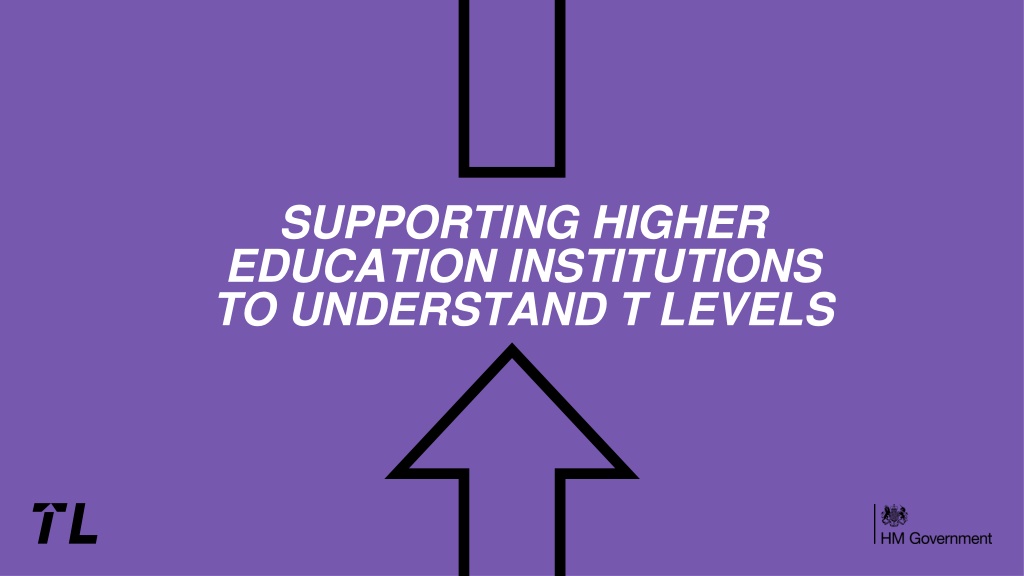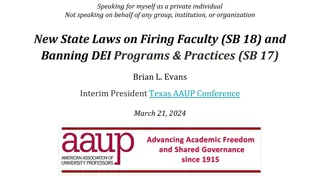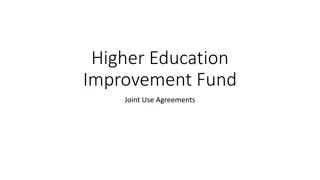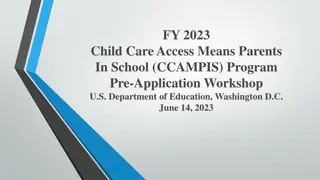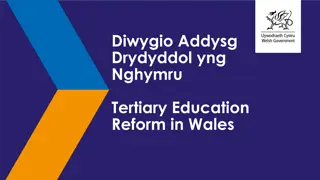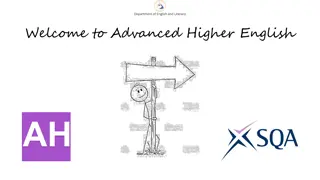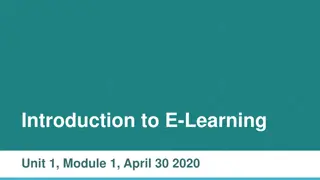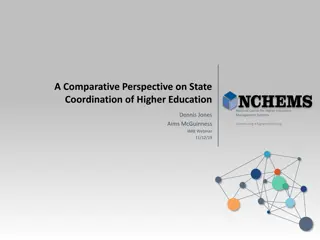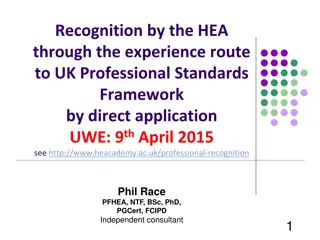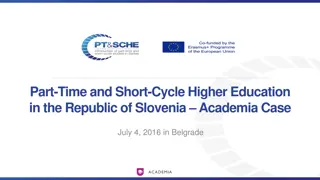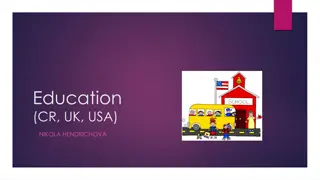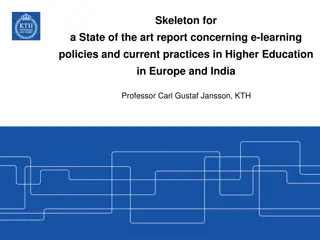Understanding T Levels in Higher Education
T Levels are a new type of two-year technical education courses designed for 16-19 year-olds, focusing on a blend of classroom learning and industry experience to prepare students for skilled employment or further study. Developed in collaboration with employers, T Levels offer a more rigorous and substantial alternative to existing technical qualifications. They provide pathways for progression into skilled employment, higher education, or apprenticeships, aligning technical education with industry needs. Transition programs are also available for students preparing to enter T Levels.
Download Presentation

Please find below an Image/Link to download the presentation.
The content on the website is provided AS IS for your information and personal use only. It may not be sold, licensed, or shared on other websites without obtaining consent from the author. Download presentation by click this link. If you encounter any issues during the download, it is possible that the publisher has removed the file from their server.
E N D
Presentation Transcript
SUPPORTING HIGHER EDUCATION INSTITUTIONS TO UNDERSTAND T LEVELS
WHAT ARE T LEVELS? New, two year technical education courses for 16-19 year olds that follow GCSEs Course includes a mixture of classroom learning (80%) and on-the-job experience (20%) during an industry placement of a minimum of 45 days Progression options include skilled employment, further study or a higher apprenticeship Developed in collaboration with employers, so that the content meets the needs of industry and prepares students for work T Levels will attract UCAS points in line with 3 A levels More rigorous and substantial than most existing technical qualifications, with longer teaching time one T Level is equivalent to 3 A levels. T Levels offer a broad course content, and students will take an occupational specialism during their programme. The specifications for the first T Levels are available online. Based on the same employer-led standards as Apprenticeships, but will suit different learning styles.
WHAT IS THE PURPOSE OF T LEVELS? Why introduce T Levels? T Levels have been introduced following the proposals by Lord Sainsbury s Independent Panel on Technical Education to provide a clear choice for students in all post-16 education pathways. We already have a well-respected and established academic pathway in A levels we want students to have high- quality options in technical pathways in a simplified qualification landscape, and ensure that all available options support good progression outcomes. We want T Levels to be part of a long-term solution that ensures technical education is more closely aligned to employers needs, providing them with the skilled workforce they need for the future. Who are they for? T Levels are for students aged 16 19 who want to study a subject that will prepare them for skilled employment or further study in a related technical field. T Levels offer broad knowledge-based content initially, with students specialising later in the course. They will suit learners who want a more practical,employer-led programme, rather than a solely classroom based programme, without the commitment of the more narrow focus of an apprenticeship. What are the progression options from T Levels? T Levels have been developed by employers and are therefore ideal for students who want to gain the knowledge and skills they need for skilled employment. The depth of knowledge and understanding gained through a T Level will also make them suitable for students who want to progress into higher-level technical study, including degree courses in subjects relevant to their chosen T Level. Finally, many T Level students will be able to move on from their course to a relevant apprenticeship if they wish to continue learning in a practical-based programme, whilst in employment.
T LEVELS CONTEXT T Level Transition Programme- targeted at students who are not ready to start a T Level but have the potential to progress onto one following a tailored preparation programme. Introduced in September 2020 by T Level providers taking part in phased implementation from academic year 2020/21, and continued with the second wave of T Levels in 2021. Review of qualifications at level 3 and below- aiming to simplify the qualifications landscape, so that every qualification is necessary, has a distinct purpose, is high quality and supports progression to positive outcomes. The government response following two consultation periods was published in July. Higher Techincal Qualifications- We re reforming higher technical education to make it a more popular and prestigious choice that provides the skills employers need. A key part of our reforms is the introduction of Higher Technical Qualifications. The first 30 Digital Higher Technical Qualifications were approved in June 2021 and will be available for teaching from September 2022, and the remaining technical routes will be rolled-out over a four-year period. Skills for Jobs White Paper- confirms the expansion of our existing reforms to increase the number of people studying high-quality technical education, including the continued rollout of T Levels, to prepare students for entry into skilled employment or higher levels of technical study including apprenticeships
T LEVELS: PROGRAMME DESIGN Up to half the qualification Knowledge and understanding of the concepts, theories and principles relevant to that sector Assessed through an external examination and a substantial project At least half of the qualification Knowledge and skills required to enter employment in that occupational specialism As close to full competence as possible Maths, English and digital competence integrated where relevant Core 900 - 1400 GLH Occupational Specialism 1800 Hrs over 2 years Between 315-420 hours Undertaken with an external employer Chance to apply skills and apply knowledge in a workplace environment Support for travel and subsistence costs but employers not expected to pay students Students required to achieve a level 2 in maths and English. Either GCSE (grade 4 and above) or level 2 Functional Skills (pass) Occupation-specific requirements included, if essential to enter employment Industry Placement Maths & English Additional requirements
HOW ARE T LEVELS ASSESSED? Core Component Assessment is an externally set written exam(s) and an employer set project. The written exams: assess route and pathway knowledge through unseen examinations. The employer set project: is a more substantial project based assessment set by employers. Grades are compensatory,that is if a student doesn t score well on the examinations but does very well on the project (or vice versa), they may still achieve a reasonable score overall. Occupational Specialism Assessment is an externally assessed project- typically broken down into a series of tasks, over a significantly longer period than the core assessment. Synoptic assessment: a single synoptic assessment ensures that students are able to demonstrate that they have accumulated knowledge and a depth of understanding across all the performance outcomes.
HOW ARE T LEVELS GRADED? TECHNICAL QUALIFICATION Core: Graded A*-E Occupational Specialism(s)- Graded Pass/ Merit/ Distinction Minimum 315hr industry placement Core Knowledge and Understanding written exam English and Maths at Level 2 Project Style assessment Employer Set Project Mandatory Additional Requirements 50%- 80% of the TQ 20%- 50% of the TQ Overall T Level Grade- Pass/ Merit/ Distinction/ Distinction* T Level grade is calculated based on the weighting of the core and occupational specialism A student must pass all components of a T Level to receive their overall T Level grade. Core Component show the full range of level 3 attainment. Occupational Specialism has significant pass grade value . Grading: Certificates will show different grades for the core and occupational specialism. For HE, the UCAS tariff is aligned to overall grades i.e. (Pass / Merit/ Distinction/ Distinction*).
UCAS POINTS AND T LEVELS UCAS tariff points were allocated to T Levels in 2019, with the top T Level grade equal to achieving 3 A* at A Level. Points have been allocated to the overall T Level grade, and students must achieve at least an overall pass grade to receive UCAS points. UCAS tariff points 168 T Level overall grade Distinction* (A* on the core and distinction in the occupational specialism) Distinction Merit Pass (C or above on the core) Pass (D or E on the core) A level A* A* A* 144 120 96 72 AAA BBB CCC DDD
WHAT MAKES T LEVELS SUITABLE FOR ENTRY INTO HIGHER EDUCATION? To help universities understand more about the T Level programme, the department has considered the requirements of T Level students and the skills they will gain through the programme compared to the success factors that students have when achieving well at higher education. These have been listed on the following slides, including examples of how this is demonstrated in T Level components and assessment. T Level Requirements Description Demonstrated Though T Level learners develop an understanding of their chosen field through breadth of content relating to the route of the field. This route and pathway knowledge is then assessed through unseen examination, which samples content, meaning breadth can be assessed at appropriate level 3 depth, whilst limiting the overall duration of assessment. Core: Written external set examinations. T Level learners develop robust depth and breadth of knowledge and understanding. Typically two 2-2.5 hours each including short answer and extended response questions. The occupational specialism allows students to develop depth of knowledge relating to their chosen specialism, with a sufficient understanding to allow them to enter the workplace. This is then assessed through a single synoptic assessment that ensures students are able to demonstrate that they have accumulated knowledge and a depth of understanding across all the performance outcomes in their specialism. Occupational specialism: Extended project assessment with employer- validated standards of performance for pass and Distinction though Grade standards Exemplification materials. Digital Production Design and Development: Performance outcomes for the occupational specialism require students to both analyse a problem to define requirements and acceptance criteria, aligned to user needs and design, implement and test software. To ensure learners achieve sufficient competence to enter the workplace, the breadth and depth of knowledge and understanding in the core and occupational specialism(s) must be applied to achieve complex outcomes. T Level leaners effectively and consistently apply knowledge and understanding to achieve complex outcomes. This is different to many unitised Vocational Qualifications where learners have a superficial understanding of their domain because they have only applied theory once for the purpose of assessment. T Level students must practice applying knowledge and skills together to reach the level of competence expected in the summative assessments. Formative assessment, which is a key part of the T Level professional development programme, not only supports learners practice but also meta-cognition, for example in how to manage and improve their own learning to achieve better outcomes.
WHAT MAKES T LEVELS SUITABLE FOR ENTRY INTO HIGHER EDUCATION? T Level Requirements Description Demonstrated Though Each T Level includes Mathematics, English and Digital competencies embedded over the whole course. The Department for Education worked closely with experts in each of these fields to develop a framework provided to employers tasked with developing the outline content for T Levels. The core tests transferable skills, in English, Maths and Digital Skills - relevant to all occupations in the route. T level learners need strong maths, digital and English skills to demonstrate their knowledge and achieve these outcomes. This framework of competencies was designed with the purpose of enabling students to deliver maths, English and digital skills in ways that require them to apply knowledge in technical contexts. This can be from strong written communication skills demonstrated in the core, to detailed mathematic competencies demonstrated in different contexts during the occupational specialism and further embedded in real-life context through the industry placement. The occupational specialism performance outcomes in Design, Surveying and Planning for Construction requires students to apply appropriate mathematical techniques to solve structural mechanics problems, including algebra, statistics, trigonometry and calculus. Awarding organisations are required to embed the competencies into the qualifications content, ensuring that the content is focused on occupational contexts and real-world application, and allowing these competencies to be assessed appropriately throughout each stage of the qualification. T Level students will be consistently demonstrating higher order thinking skills throughout the different requirements of the programme. They will take a well-considered problem-solving approach to critically analyse and evaluate situation, such as determining whether a solution will meet an employers need in Employer Set Project. They will also be required to provide extended responses in examinations and make determinations of the appropriate approach to reach the best outcome in the occupational specialism. Higher order thinking skills are fundamental to success at level 3 and, as the course is assessed to a level 3 depth, are therefore present throughout the whole technical qualification. T Level learners need higher order thinking skills, including critical thinking in order to put theory into practice. Operating in this way is also essential to success in the workplace in higher level roles, as it requires individuals to think beyond performing a prescribed procedure and allows for initiative to be taken based on the specific context, which is why T Level students will be taught through the programme to develop these skills.
WHAT MAKES T LEVELS SUITABLE FOR ENTRY INTO HIGHER EDUCATION? T Level Requirements Description Demonstrated Though Developing skills as a self-directed learner will be integral to success on this programme. Through the employer set project, students are required to independently derive a solution to a problem set by an employer. They are also required within the employer set project brief- based assessment to independently research information in relation to the problem provided to them before their assessment, and utilise this knowledge to support their decision making in assessment, so will acquire research skills alongside self-proficiency. T Level learners need to be collaborative and self-directed learners to prepare for their summative assessments (e.g. exams) and complete their industry placement. Alongside the employer set project, the occupational specialism and industry placement will allow students to develop skills in working collaboratively to reach solutions. Underpinning all these skills, is a diverse range of different basic requirements that students will need to develop over the course of their programme. This includes teamworking, organisation, time management and planning. Many of these skills will form part of their objectives for their industry placement, and will set them up well for employment. T Level learners need strong management and organisations skills to succeed in all elements of the programme. The industry placement learning goals include specific requirements for students to hone their skills developed in the technical qualifications such as planning, students need to identify discrete steps, estimate time and resources, prioritise and sequence activity to demonstrate success in their placement.
HOW ARE WE SUPPORTING FE TEACHERS TO DELIVER T LEVELS? Part of offering excellent courses in technical education, is making sure that teachers and leaders have the support they need to deliver them well. The T Level Professional Development (TLPD) offer, currently being delivered by The Education and Training Foundation (ETF) supports staff delivering T Levels with the teaching skills, subject knowledge and confidence they need for the benefit of their learners. Support ranges from training needs analyses, CPD, and professional development for leaders, through to industry insights and opportunities for collaboration and networking. A key strand of T Level CPD has been supporting practice in diagnostic and formative assessment to ensure students are well prepared for the summative assessment at the end of their course and any necessary intervention or support can be identified early on. There has also been CPD work by ETF in upskilling teachers to deliver the Maths and English skills for the level 2 requirement in T Levels, and we are exploring further how we can support teachers to deliver the embedded Maths, English and Digital content in T Levels. In addition to CPD, we are also supporting FE teaching through the Taking Teaching Further (TTF) programme, to recruit and train experienced industry professionals to work in FE - aiming to boost the quality and industry-relevance of teaching. To ensure schools and colleges have support in designing the curriculum, the Awarding Organisations have also produced employer validated Guide Standard Exemplification Materials that show the expected standard of attainment. These standards are validated yearly by employers to ensure the attainment has continued currency.
T LEVELS: MATHS AND SCIENCE Universitiestold us that to make decisions on entry criteria they would like a resource which demonstrates the maths content in T Levels, particularly compared with A levels. When T Levels were developed, we worked with the Royal Society Advisory Committee on Mathematics Education (ACME) to ensure appropriate expert advice on mathematics education was available to the employer panels charged with developing T Levels. ACME developed a framework of General Mathematical Competencies (GMCs), designed with the purpose of enabling students in ways that require them to apply maths skills technical contexts. Awarding organisations are required to embed maths competencies into the qualifications content, ensuring that the content is focused on occupational contexts and real-world application. Therefore, it is difficult to isolate and grade the maths skills of a T Level student, as they are required to demonstrate them in an applied way throughout their course and assessment. To try and demonstrate the maths content in T Levels, we have mapped the maths content within the specifications to A Level maths to show comparable coverage. We will also set out where the maths content in T Levels covers knowledge outside of A level maths. We shared this through UCAS, along with a standalone slide deck on T Levels in May last year. To support understanding of coverage, we encourage universities to consider the mapping in the context of the specifications,so they can see the way that maths is taught and assessed applied in real-life contexts. We will continue to share maths mapping products as more specifications are published for new T Levels in relevant areas. We have also developed a draft science mapping for the Health and Science Wave 2 T Levels. This is currently with the Royal Society for comment, with a view to share with universities in the new year.
WHAT SUPPORT IS AVAILABLE FOR UNIVERSITIES FROM AWARDING ORGANISATIONS? Wave 1 Design, Surveying and Planning for Construction/Digital Production, Design and Development- Pearson Pearson have produced a wide range of materials to support providers in understanding the specification. The link to the specifications is For providers | Pearson qualifications Pearson have also produced getting to know the specification webinars and these are available on Pearson's website. They are broken down into two webinars per TQ, one focusing on the core (part A) and one focusing on the Occupational Specialism (Part B). These can be found at: Getting to Know the Specification: (Digital Production, Design and Development T Level) Part A (on24.com) Getting to Know the Specification: (Digital Production, Design and Development T Level) Part B (on24.com) Recording: Construction - Design, Surveying and Planning T Level: Getting to Know the Specification (PART A) (on24.com) Recording: Construction - Design, Surveying and Planning T Level: Getting to Know the Specification (PART B) (on24.com) Education and Childcare- NCFE NCFE have produced a HEI information pack, that was shared with universities in the Autumn, which can be found here: https://www.ncfe.org.uk/t- levels/creating-the-next-generation-of-skilled-workers In addition, NCFE have a number of recorded webinars covering a variety topics all available on their YouTube channel- NCFE - YouTube Wave 2 The specifications for all Wave 2 T Levels have also been published and can be found at the Awarding Organisations websites: T Level Technical Qualification in Healthcare Science (Level 3) (Delivered By NCFE) (qualhub.co.uk) T Level Technical Qualification in Health (Level 3) (Delivered By NCFE) (qualhub.co.uk) T Level Technical Qualification in Science (Level 3) (Delivered By NCFE) (qualhub.co.uk) T Level Technical Qualification in Digital Support Services (Level 3) (Delivered By NCFE) (qualhub.co.uk) T Level Technical Qualification in Digital Business Services (Level 3) (Delivered By NCFE) (qualhub.co.uk) T level Technical Qualification in Onsite Construction qualifications and training courses | City & Guilds (cityandguilds.com) T Level Technical Qualification in Building Services Engineering for Construction qualifications and training courses | City & Guilds (cityandguilds.com)
